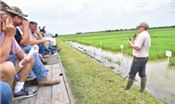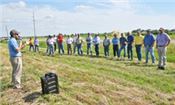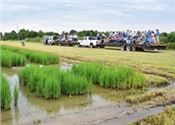|
Economist Sees Favorable Rice Price Outlook
LAKE ARTHUR, LA.
An LSU AgCenter economist had good news for rice farmers at the Vermilion Parish rice field day on June 11.
“Optimism is high that with recaptured market share in core markets, the outlook for rice is positive from a price standpoint,” saidMichael Deliberto.
He told farmers American rice has become more competitive, which could allow the U.S. to regain market share in Latin America.
The improved trade outlook combined with decreased U.S. rice acreage has led the U.S. Department of Agriculture to increase its projected long-grain price to $10.50 per hundredweight and the medium-grain price to $11 cwt., a 50-cent increase from the previous USDA estimate, Deliberto said.
Iraq has agreed to buy 120,000 metric tons of U.S. rice, but it’s unclear if that country will consistently be an American customer.
The prospect of selling rice to China remains viable, but no deals have been reached yet, Deliberto said.
China has been selling rice in Puerto Rico, and China has become taking away U.S. market share in the Mediterranean.
At the Acadia Parish rice field day on June 12, farmers heard about extensive weed research being conducted at the South Farm of the AgCenter H. Rouse Caffey Rice Research Station. AgCenter weed scientist Eric Webster showed farmers several herbicide studies he is conducting with his graduate students.
Graduate student Sam Rustom has a study of mixing Loyant with Provisia.
One study is looking at the rates of Loyant that can damage soybeans from drift. Small droplets of Loyant, 2,4-D and dicamba can damage nearby crops. “If you’re putting Loyant out next to a soybean field, be very careful. It takes only a small amount to get activity,” Webster said.
Another study is being conducted to see if rice seed germination is affected by late-season herbicide applications.
Testing also is being conducted on herbicide timing and rates for a wide range of products, said graduate student Connor Webster.
AgCenter rice breeder Adam Famoso said two Clearfield lines are possible candidates for release as varieties.
The line 2097 has a yield increase over CL153 by 5 percent, but the grain quality is an issue with a higher amount of chalk. Another line, 2195, has 3 percent to 5 percent less yield than CL153 but with better grain quality than 2097, he said.
Foundation seed is being grown for both lines, Famoso said, so if either is released at the end of this year, seed production could start in 2020. “At the end of the season, we’ll make a final decision,” he said.
A new Provisia variety was approved this year, but work continues on more possibilities with the Provisia technology. “We’ve got plenty of other lines in the Provisia pipeline,” Famoso said.
AgCenter plant pathologist Don Groth said he has received sheath blight disease reports. “It’s actually getting a later start compared to previous years,” he said.
Fungicide-resistant sheath blight can be controlled with Elegia. Amistar Top didn’t work as well as expected last year, but more research is being done to see if its effectiveness can be improved, Groth said.
It appears this won’t be a bad year for Cercospora. But Cercospora will become apparent earlier on late-planted rice, he said.
AgCenter rice specialist Dustin Harrell said heavy rainfall this spring has created more challenges for growing rice. Most of it was planted the third week of March. “We were fighting the weather from the get-go,” he said.
The last big rain probably claimed 200 acres of rice, and one farmer has had his crop submerged three times after heavy rains this year.
“It’s all been about fighting the water,” said Andrew Granger, AgCenter agent in Vermilion Parish.
Some uneven emergence of rice plants has occurred on some fields, probably from cool soil temperatures, Harrell said.
AgCenter entomologist Blake Wilson said the seed treatment Fortenza used with Cruiser Maxx has been as effective as Dermacor against rice water weevils, but it has no activity on stem borers.
Stem borers can take away as much as 5 percent to 10 percent of crop yield.
Dermacor can even be effective on stem borers in the ratoon crop, Wilson said.
AgCenter plant pathologist and soybean specialist Boyd Padgett said research is being done to find flood-tolerant soybean varieties.
Soybeans can survive flooding for 48 to 96 hours, depending on conditions.
Padgett recommended farmers wait four to five days before deciding whether they will replant a soybean field that has flooded. ∆

LSU graduate student Conner Webster, speaking at the Acadia Parish rice field day on
June 12, talks about one of several studies of Provisia herbicide.
Photo by Bruce Schultz/LSU AgCenter

LSU AgCenter rice specialist Dustin Harrell, far left, tells farmers at the Vermilion Parish rice field
day on June 11 about fertilizer strategies they should consider for their rice crop.
Photo by Bruce Schultz/LSU AgCenter

At stop on the field tour during the Acadia Parish rice field day on June 12, LSU AgCenter weed scientist
Eric Webster talks about a study of herbicide effectiveness on aquatic weeds.
Photo by Bruce Schultz/LSU AgCenter
|
|